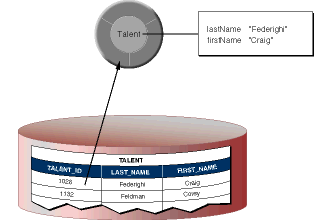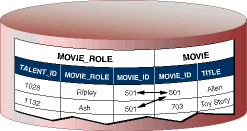Enterprise Objects and Relationships
Relational databases model not just individual entities, but entities' relationships to one another. For example, a movie has zero, one, or more roles. This is modeled in the database by both the MOVIE table and MOVIE_ROLE table having a MOVIE_ID column. In the MOVIE table, MOVIE_ID is a
primary key, while in MOVIE_ROLE it's a
foreign key.
A primary key is a column or combination of columns whose values are guaranteed to uniquely identify each row in that table. For example, each row in the MOVIE table has a different value in the MOVIE_ID column, which uniquely identifies that row. Two movies could have the same name but still be distinguished from each other by their MOVIE_IDs.
A foreign key matches the value of a primary key in another table. The purpose of a foreign key is to identify a relationship from a source table to a destination table. In the following diagram, notice that the value in the MOVIE_ID column for both MOVIE_ROLE rows is 501. This matches the value in the MOVIE_ID column of the "Alien" MOVIE row. In other words, "Ripley" and "Ash" are both roles in the movie "Alien."
Suppose you fetch a Movie object. Enterprise Objects Framework takes the value for the movie's MOVIE_ID attribute and looks up movie roles with the corresponding MOVIE_ID foreign key. The framework then assembles a network of enterprise objects that connects a Movie object with its MovieRole objects. As shown below, a Movie object has an array of its MovieRoles, and the MovieRoles each have a Movie.
© 1999 Apple Computer, Inc. – (Last Updated 24 Aug 99)





